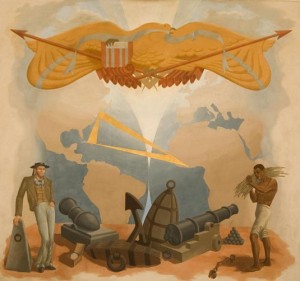The Medford Slave Trade Letters — 1759-1765

Painted by Henry Billings. Learn more about the history of the WPA mural here.
The “Medford Slave Trade Letters” as they were called in their original accession are a series of letters spanning between the January of 1759 and October of 1765. A six-year correspondence between Timothy Fitch, a merchant and Medford resident, and his employee named Peter Gwinn. The letters are a direct and local link to the trafficking and sale of enslaved human beings from Africa. The letters originate from the Hall family of Medford and are housed at the Medford Historical Society & Museum.
The details of the letters bring to life the middle passage and movement of enslaved individuals from their homeland in Africa to the United States and the Caribbean. In these documents the realities and horrors of the Atlantic Slave Trade come to life in their formal details including: types of slaves who were to be purchased, methods of enhancing marketability of individuals, marketing ploys, deadlines, desirable markets for the sale of slaves, methods of treating the captive slaves, instructions regarding the sale of slaves upon reaching the United States and Caribbean, and instructions for avoiding pirates and customs.
The letters reveal the realities and truths of the Atlantic Slave trade and remain an historic link and witness to eighteenth-century human trafficking.
The Project Statement
The goal of this project has been to preserve an essential and valuable part of history. In these letters we hope to offer a resource on the atrocities of the eighteenth-century slave trade.
Timothy Fitch
Timothy Fitch was born on October 23, 1725, the fourth child born to Joseph and Margaret Fitch of Boston, Massachusetts. Throughout his lifetime Timothy’s family, residing in Medford, maintained close ties to their Boston roots. Today, the remains of Timothy’s father Joseph and brother Jeremiah are found at the Granary Burial Ground on Tremont Street in Boston.
Married twice, Timothy Fitch’s first marriage was to Abigail Hall Donaghue (the widow of Captain David Donaghue) on January 1, 1745. The couple lived in Medford, Mass. And had at least five children: Abigail, Timothy, Rebecca, Hannah and Elizabeth. It is believed that Abigail, Timothy’s wife, died prior to 1760, although the exact date is not known for sure.
Timothy’s second marriage was on October 16, 1760 and was to Eunice Brown Plaisted, the widow of lchabod Plaisted of Salem, MA. During this thirty-year marriage at least four children were born: John Brown, Charles, Eunice and Hannah Brown. The family divided their time between their Boston, Medford, and Salem homes. It was during this time in his life that Timothy Fitch engaged in the slave trade and kept a correspondence with a captain of one of his ship’s named Peter Gwinn.
A merchant by profession, Timothy Fitch conducted business in several New England communities including, but not limited to, Medford, Boston, Salem and Nantucket. Fitch owned several ships including the Snow Caesar or the Caesar, and a schooner by the name of The Charming Phyllis, The Phyllis or the Schooner Phyllis. The trade and cargo of these ships included rum molasses, various other dry goods, but most importantly these ships were directly involved in the trade and trafficking of African Slaves.
Timothy Fitch died in Medford on September 28, 1790. The listed cause of death was “diarrhea.”
The letters came to MHSM through the Hall family of Medford. John Brown Fitch, the son of Timothy and Eunice, was married to Hepzibeth Hall. They had five children; John Brown died on January 25, 1785. Thus the connection to the Hall family.
The Letters
1759 January, 14
Voyage one by Capt. William Ellery on behalf of Timothy Fitch
1759 August, 21
Bridge Town Barbados list of slaves auctioned off
1760 January, 12
Peter Gwinn’s first voyage (on record) on behalf of Timothy Fitch
1760 November, 8
Voyage for Timothy Fitch made by Capt. Peter Gwinn
1760 November, 8
Invoice Sundry Merchandize Shipt
1761 September, 4
Voyage by Capt. Peter Gwinn to Senegal, on behalf of Timothy Fitch
1761 November, 1
Letter to Peter Gwinn mid-voyage
1762 October
Capt. Peter Gwinn makes another voyage on behalf of Timothy Fitch
1762 October, 30
Invoice Sundry Merchandize Shipped
1763 September, 23
Invoice and letters from Frans. Minot and William Sader to Timothy Fitch
1764 March, 5
Mid-voyage letter and contract for Capt. Peter Gwinn from Timothy Fitch
1765 June, 4
Correspondence mid-voyage from Timothy Fitch to Peter Gwinn
1765 October
Correspondence mid-voyage from Timothy Fitch to Peter Gwinn – 2
1765 November, 1
Correspondence mid-voyage from Timothy Fitch to Peter Gwinn (to Surinam)
1766
Account/Invoice for sale of slaves
1769 November, 27
Voyage by Peter Gwinn on behalf of Timothy Fitch on “Snow Fair Lady.”
Transcription of the letters are thanks to Jay B. Griffin, Past-President of the Medford Historical Society, who obtained grant funding from the Massachusetts Cultural Council to preserve this collection of slave trade correspondence. Mr. Griffin and Professor Rosalind Shaw of Tufts University worked with students from Tufts University in the spring of 2000.
Transcribed by: Tufts University students Andrea Johnson and Philip Keitel for Anthropology 185: “Memories of the Slave Trade” Professor Rosalind Shaw Spring, 2000.
